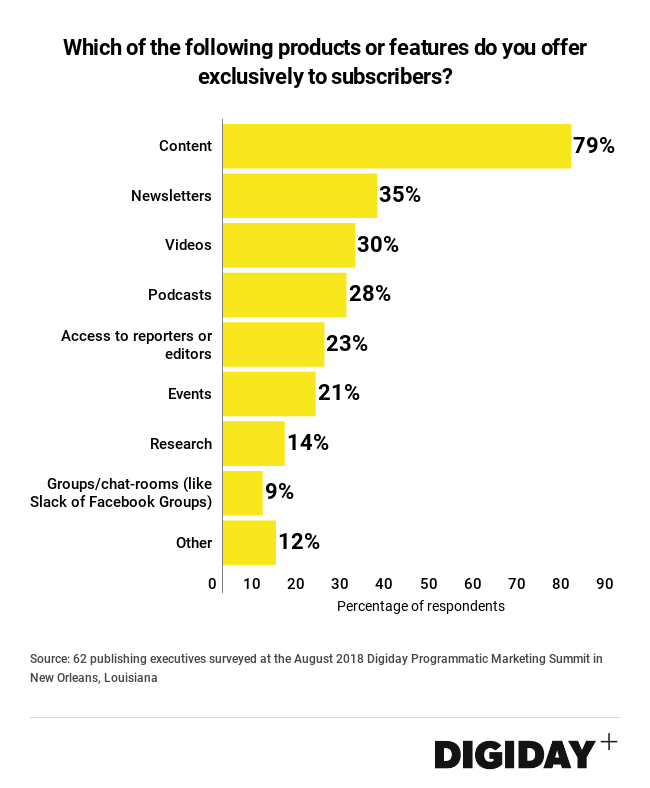Connect with execs from The New York Times, TIME, Dotdash Meredith and many more
Digiday Research: More than a third of publishers are using newsletters to get people to subscribe

This research is based on unique data collected from our proprietary audience of publisher, agency, brand and tech insiders. It’s available to Digiday+ members. More from the series →
Premium or paywalled content is the most common feature of publishers’ subscriptions. But beyond content, publishers are relying on products like newsletters to attract new users and test out potential markets, according to a survey conducted by Digiday this August.
Of the 62 publishers polled at the Digiday Hot Topic: Subscriptions and Memberships event, the average publisher’s subscription contains just over two products. Seventy-nine percent of respondents said their subscriptions included content, the only feature used by the majority of publishers. But many are using newsletters as well as multimedia content like podcasts or video as subscriber-only content.
For example, though the Washington Post only introduced subscriber-only content earlier this year, it complements its subscriptions with exclusive newsletters and podcasts in an effort to create a unique experience for readers.
Newsletters can also be used strategically. Politico introduced subscriber-only newsletters to gauge user interest for Politico’s content in new European countries. By focusing on exclusive newsletters, readers have the chance to personally support writers they care about because many newsletters are specially curated by reporters.
Other publishers such as New York Magazine are focusing on events to help create experiences for consumers. Similarly The Information, a subscription-only publisher, offers its members access to annual parties where they can network.

Given that only 8 percent of U.S. consumers pay for a news subscription and consumers would rather pay for experiences than products, publishers bundling more unique products, specifically experience oriented ones, in their subscriptions could be key to their success.
The fact though that publishers have yet to concentrate around a single product besides content also points to how unique publishers’ audiences are. What works for one publisher is unlikely to resonate with other audiences. Publishers pivoting subscriptions is also a recent phenomenon so as their products mature, they’ll find new services they can incorporate.
More in Media

Retail media meets publishing: News UK, Future and Ocado tap clean room tech for smarter data targeting
News UK, The Independent, Immediate Media and Future are teaming up with retail media network Ocado to test clean room-powered data matching.

From sidelines to spotlight: Esports events are putting creators center stage
Esports events’ embrace of content creators reflects advertisers’ changing priorities across both gaming and the wider culture. In the past, marketers viewed esports as one of the best ways to reach gamers. In 2025, brands are instead prioritizing creators in their outreach to audiences across demographics and interest areas, including gaming.

Condé Nast and Hearst strike Amazon AI licensing deals for Rufus
Condé Nast and Hearst have joined the New York Times in signing a licensing deal with Amazon for its AI-powered shopping assistant Rufus.





